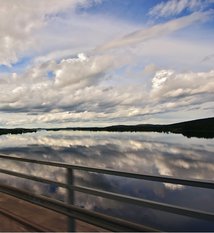Border: Finland-Sweden
Date(s) of establishment: 1809; Current demarcation in 1985Length of border: 614 km
Regions concerned: Finland – Lapland; Sweden – Norrbotten
European programme(s):
- Interreg IV A "North":
Website of the programme
The programme on the Inforegio website - Interreg IV A "Botnia-Atlantica":
Website of the programme
The programme on the Inforegio website - Interreg IV A "Ce,trcentrale" :
Website of the programme
The programme on the Inforegio website
Stretching over 614 km, the border begins in the north in Lapland, at the tripoint marked by the “Three-Country Cairn” or “Treriksröset”. Next it takes a southerly direction, and follows the rivers Konkamaeno and Muonia, followed by the Torne, before reaching the Bothnian Bay, the northernmost part of the Baltic Sea. This demarcation is that of the terrestrial border between the two countries. The border continues along two islands in the Baltic Sea: Kataja and Märket.
History
The border between the two countries was created in 1809 when Sweden ceded Finland to the Russian Empire in the Treaty of Fredrikshamn, ending the Finnish War. Having long been fully integrated into the Kingdom of Sweden, under the treaty these territories became the Grand Duchy of Finland, an autonomous province within the Russian Empire. Following the fall of the latter, Finland became an independent state in 1917, the demarcation of 1809 remaining unchanged up to this point.
At its inception, the boundary line did not cross the Swedish island of Kataja. The island is now crossed by a border because the Finnish island of Inakari has become attached to it, due to the postglacial rebound affecting this area. The once maritime border has now become a terrestrial one.
Aside from this detail, the boundary line has been changed only once, in 1985, on the island of Märket, after geographers realised that the Finnish lighthouse was actually on the Swedish side. The border was therefore modified to avoid any impact on the delimitation of fishing zones.
Cross-border cooperation
The northern location of the border region makes its cooperation needs very specific. The objective of the Interreg 'North' programme is to ensure the cohesion of the region, notably by implementing quality transport infrastructure. The improvement of this infrastructure in intended to increase contacts between populations, the movement of persons being facilitated by Sweden and Finland’s membership of the Schengen area.
Moreover, this region, with its ageing population, is in shortage of businesses. The EU programme thus aims to stimulate the economy in order to attract new entrepreneurs. Activities concerning research and development are supported in priority, as well as measures permitting the creation of a favourable environment for the creation of innovative organisations.
In addition, the Interreg programme has developed a sub-programme named “SAPMI” which, while covering a larger area, aims to give a boost to cultural activities and to ensure the overall development of the region. The two Euroregions ("North Calotte Council" and "Mittnorden Comittee") also propose cultural activities (Nordic Culture days) in order to reinforce the region’s identity.
The northern part of the two countries also benefit from Interreg funding, thanks to the cooperation programme “Botnia-Atlantica”. This programme aims to improve cooperation structures, notably in the areas of communications and culture.
Furthermore, the Baltic Sea region as a whole benefits from another operational programme concerning coastal countries. Its main objective is to raise populations’ awareness of environmental issues in order to create a more secure natural environment (reduction of accidents in the Gulf of Finland). Other projects also support the regional economy and the establishment of a dynamic society promoting equal opportunities for its inhabitants.
At the local level, at the south end of the border, active cooperation is underway within the cross-border conurbation Haparanda-Tornio.
Photo copyright: Hermann Hops


